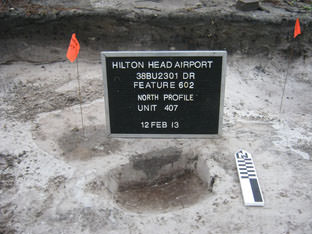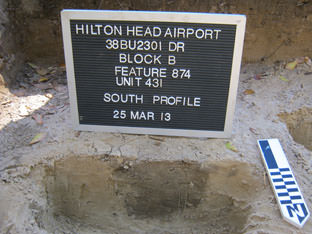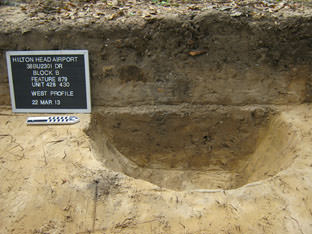Marks of Freedom
What is a Feature?
People create soil anomalies archaeologists call features when they build houses, dig garbage pits, wells, cellars, and latrines, sweep their yards, build a fire, and many other activities. A feature can be a piece of house foundation, a stain left by a rotted post, a hole where someone buried garbage, a camp fire, a scatter of shells and bones where someone ate a meal, anywhere a human activity left its mark.
Features at Mitchelville
“Some are made of round poles chinked with oyster-shell lime; some of slats; and some of boards, picked up and bought, of every conceivable size, while others are 'pieced out' with old canvas on the chimneys and roof."
Freedmen's Journal 1865



During the 2013 study, archaeologists investigated the southwestern edge Mitchelville. An 1865 map shows nearly 50 houses were built in this part of the town. Photographs from 1864 show what some of the Mitchelville houses looked like and give us clues to the kinds of features archaeologists might find in the ground. Archaeologists knew the buildings were long gone. They wondered if any evidence of houses would remain as features. There are many factors that determine whether features form in the soil. Archaeologists studying Mitchelville worried there might not be features because:
- The houses were not there very long.
- The house foundations were shallow.
- The 1893 hurricane washed buildings away.
- The houses were dismantled and removed.
Archaeologists working at Mitchelville found soil stains that marked old house posts, garbage pits, wells, and cellars. There were:
- 38 Posts
- 2 Wells
- 6 Garbage pits
- 2 root cellars
- 1 Ditch
- 2 Storage pits
What is a Post Hole?
Post hole features are often found on archaeological sites. They are evidence that a person dug a hole, inserted a wooden post, and refilled the hole around the post with dirt. As the post rots, it adds organic material to the post hole and turns the soil a darker color. Posts holes can be the remnants of houses, buildings, fences, palisades, or any structure with a wooden frame. Patterns of post holes can define where buildings or structures once stood, the shape of the building, and even whether the buildings were repaired. Archaeologists find posts on many kinds of sites, including sites where Native Americans lived.
Renty Gibson's House
Archaeologists found post holes they think were part of three former Mitchelville houses, including Benjamin "Renty" Gibson's house. Renty Gibson was born on Hilton Head Island in 1836. In 1863, he enlisted in the 21st USCT and served as a teamster in the Quartermaster's department. After the war Gibson returned to Hilton Head Island and took up farming with his wife Judy. In 1899, Gibson purchased six acres of land from Viola Holmes — land that had once been part of Mitchelville. Renty and Judy Gibson refurbished or built a new home on their land. This may be one of the houses archaeologists found during the 2013 excavations. Renty Gibson died at Hilton Head Island on May 18, 1909 and is buried in the Government Cemetery with a military marker.
